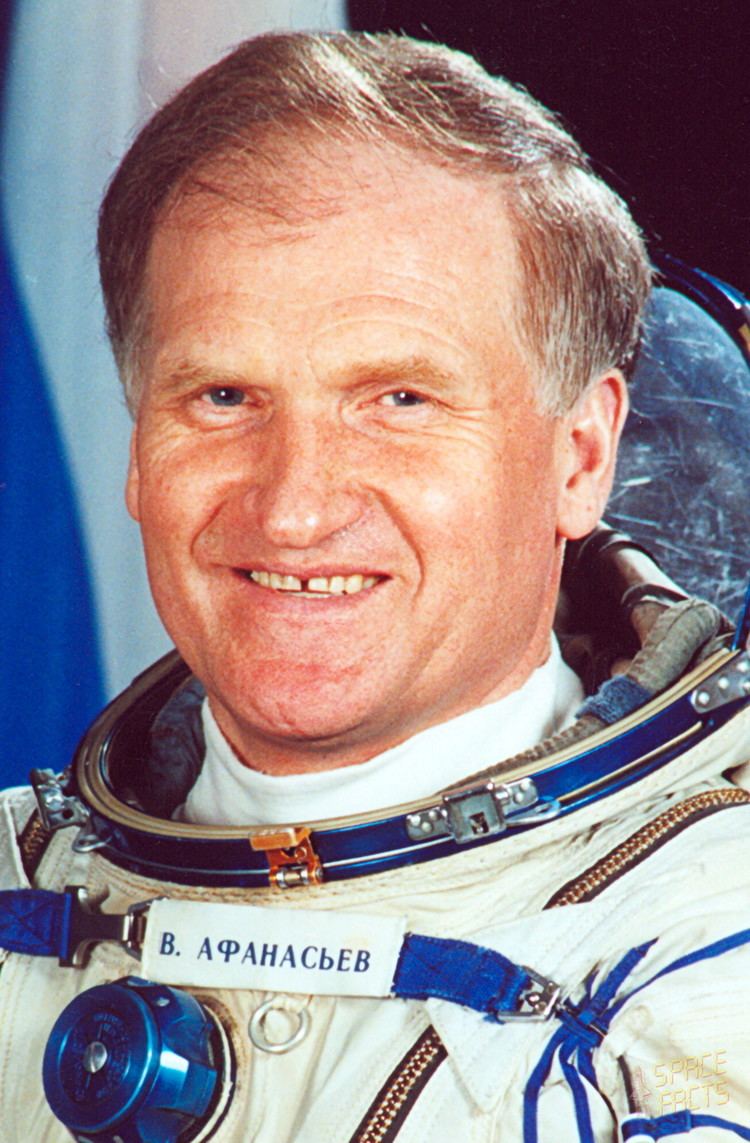Viktor Afanasyev
Russian - (RFSA)
Retired
Date of Birth: Dec. 31, 1948
Age: 77
Viktor Mikhailovich Afanasyev Russian: Виктор Михайлович Афанасьев; born 31 December 1948) is a colonel in the Russian Air Force and a test cosmonaut of the Yu. A. Gagarin Cosmonaut Training Center.
Soyuz-U2 | Soyuz TM-11
Soviet Space Program | RussiaBaikonur Cosmodrome, Republic of Kazakhstan
Dec. 2, 1990, 8:13 a.m.
Status: Success
Mission:
Soyuz TM-11 was the 11th mission and the eighth long-duration expedition to Mir space station. The mission began on December 2, 1990, 08:13:32 UTC, launching Commander Viktor Afanasyev, Flight Engineer Musa Manarov and Research Cosmonaut Toyohiro Akiyama, the first space tourist, into orbit. They docked with Mir two days later. During their stay there, cosmonauts performed EVAs, various station repair and maintenance tasks, and carried out scientific experiments in biology, geophysics, space technology, astronomy etc. They were visited by several Progress resupply spacecrafts, and welcomed aboard the ninth long-duration expedition crew, which arrived in Soyuz TM-12 vehicle. Toyohiro Akiyama returned on December 10, 1990, in Soyuz TM-10 spacecraft, while the mission itself concluded with a safe landing back on Earth on May 26, 1991, 10:04:13 UTC.
Low Earth OrbitSoyuz-U2 | Soyuz TM-18
Soviet Space Program | RussiaBaikonur Cosmodrome, Republic of Kazakhstan
Jan. 8, 1994, 10:05 a.m.
Status: Success
Mission:
Soyuz TM-18 was the 18th mission and the 15th long-duration expedition to Mir space station. The mission began on January 8, 1994, 10:05:34 UTC, launching Commander Viktor Afanasyev, Flight Engineer Yury Usachov and Research Cosmonaut Valeri Polyakov into orbit. They docked with Mir two days later. During their stay there, cosmonauts carried out various scientific experiments in medicine, material sciences, astrophysics etc. Station crew was visited by several Progress resupply spacecrafts, and welcomed aboard the Soyuz TM-19 crew. The mission concluded with a safe landing back on Earth on July 9, 1994, 10:32:35 UTC.
Low Earth OrbitSoyuz-U | Soyuz TM-29
Russian Federal Space Agency (ROSCOSMOS) | RussiaBaikonur Cosmodrome, Republic of Kazakhstan
Feb. 20, 1999, 4:18 a.m.
Status: Success
Mission:
Soyuz TM-29 was the 38th mission and the 27th long-duration expedition to Mir space station. The mission began on February 20, 1999, 04:18:01 UTC, launching Commander Viktor Afanasyev, Flight Engineer Jean-Pierre Haigneré and Research Cosmonaut/Fight Engineer Ivan Bella, who became the first Slovakian cosmonaut, into orbit. They docked with Mir two days later. During their stay there, cosmonauts performed several EVAs and various scientific experiments. Station crew was visited by several Progress resupply spacecrafts. The mission concluded with a safe landing back on Earth on August 28, 1999, 00:34:20 UTC.
Low Earth OrbitSoyuz-U | Soyuz TM-32
Russian Federal Space Agency (ROSCOSMOS) | RussiaBaikonur Cosmodrome, Republic of Kazakhstan
April 28, 2001, 7:37 a.m.
Status: Success
Mission:
Soyuz TM-32 was a visiting mission to ISS, which carried 3 cosmonauts and astronauts. Russian Commander, cosmonaut Talgat Musabayev alongside Flight Engineer, Yuri Baturin and Flight Engineer/Spaceflight Participant Dennis Tito launched aboard the Soyuz spacecraft on April 28, 2001, 07:37:20 UTC. They docked with the station two days later. During their stay there, crew assisted Expedition 2 members in station work. Soyuz TM-32 crew returned aboard Soyuz TM-31, landing safely back on Earth on May 6, 2001, 05:41:28 UTC.
Low Earth OrbitSoyuz U | Soyuz TM-33
Russian Federal Space Agency (ROSCOSMOS) | RussiaBaikonur Cosmodrome, Republic of Kazakhstan
Oct. 21, 2001, 8:59 a.m.
Status: Success
Mission:
Soyuz TM-33 was a visiting mission to ISS, which carried 3 cosmonauts and astronauts. Russian Commander, cosmonaut Viktor Afanasyev alongside Flight Engineer, ESA astronaut Claudie Haigneré and Flight Engineer/Spaceflight Participant, Konstantin Kozeyev launched aboard the Soyuz spacecraft on October 21, 2001, 08:59:35 UTC. They docked with the station two days later. During their stay there, crew assisted Expedition 3 members in station work. Soyuz TM-33 crew returned aboard Soyuz TM-32, landing safely back on Earth on October 31, 2001, 05:00:00 UTC.
Low Earth OrbitThe Roscosmos State Corporation for Space Activities, commonly known as Roscosmos, is the governmental body responsible for the space science program of the Russian Federation and general aerospace research. Soyuz has many launch locations the Russian sites are Baikonur, Plesetsk and Vostochny however Ariane also purchases the vehicle and launches it from French Guiana.
Long March 3B/E
Fengyun-4C
Launch Complex 2 (LC-2) - Xichang Satellite Launch Center, People's Republic of ChinaChina's geostationary meteorological satellite program FY-4 (Feng Yun 4) is the second generation of chinese geostationary meteorological satellites.
Long March 8A
SatNet LEO Group 17
Commercial LC-1 - Wenchang Space Launch Site, People's Republic of ChinaA batch of 9 Low Earth Orbit communication satellites for the Chinese state owned SatNet constellation operated by the China Satellite Network Group.…
Soyuz 2.1a
Obzor-R No.1
43/4 (43R) - Plesetsk Cosmodrome, Russian FederationNote: Assignment of payloads to this launch is uncertain. The Russian Obzor-R satellite is a planned X-band radar earth observation satellite desi…
LVM-3 (GSLV Mk III)
BlueBird Block 2 #1
Satish Dhawan Space Centre Second Launch Pad - Satish Dhawan Space Centre, IndiaAST SpaceMobile’s Block 2 BlueBird satellites are designed to deliver up to 10 times the bandwidth capacity of the BlueBird Block 1 satellites, requi…
Long March 12A
Demo Flight
Long March 12A Pad - Jiuquan Satellite Launch Center, People's Republic of ChinaFirst test launch of CASC/SAST’s Long March 12A rocket, with a dummy payload. The rocket’s 1st stage attempted to land on a landing pad about 300 km …




